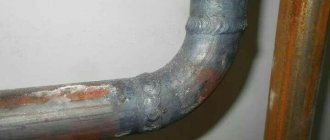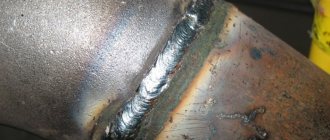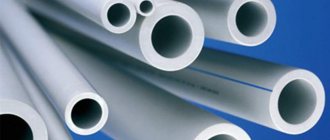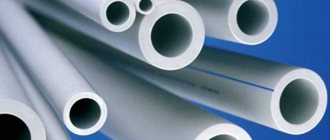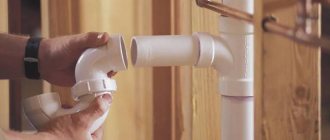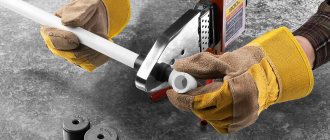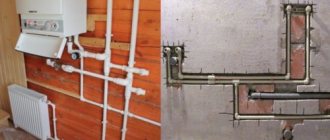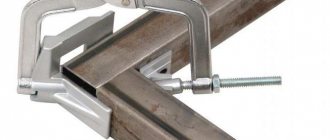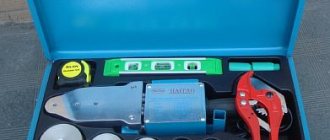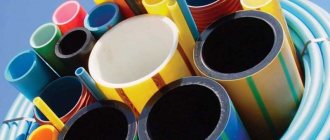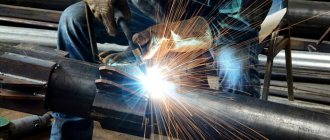Reliable heating and plumbing are firmly rooted in people’s lives; the main load-bearing material for water movement is polypropylene pipes, but to prevent unexpected problems from spoiling the comfort in the house, you need to know all the nuances of welding for their reliable tightness.
This article describes general concepts regarding reliable soldering of polypropylene pipes for beginners, based on what method the fittings are connected to pipes and what its essence is. How the welding operation is carried out and what should be under the control of the welder.
A list of necessary tools for high-quality soldering and what preliminary work needs to be done so that the quality of subsequent actions is at the highest level. Why is it necessary to carry out the procedure of degreasing a fitting with a pipe blank and what can result from ignoring this operation.
How to correctly determine the planting depth and marking of a pipe product and what the consequences of planting the pipe material too deeply lead to. How much time should be devoted to heating the plastic elements, as well as what temperature is considered optimal for performing the work and how to avoid the effect of rapid cooling of the heated structure.
Discussion of the important nuances of competent soldering: the main stages of welding using the polyfusion method, how it proceeds using electrofitting, what criteria must be observed during diffuse welding, as well as a description of the effectiveness of welding using the socket and butt method.
What points must be avoided during welding, how pipe systems are laid and how to install communications of polypropylene pipes in the room. What types of welding machines are there and tips for choosing them well.
Disclosure of the main mistakes during soldering: what the presence of water and dirt on the soldered elements leads to, the consequences of incorrect connection, the dangers of choosing the wrong material and what the consequences of not following the basics of installation are.
How to properly solder polypropylene pipes - general concepts
At first glance, this process seems very simple. They heat up the elements, connect them, and fasten them. But practice has proven that there are many nuances in such actions, neglect of which will lead to a poor-quality result, that is, a poorly functioning highway, and novice craftsmen need to pay close attention to certain points.
The main problem is that poorly done work can only be determined after a certain time of operation of the highway. Therefore, it is so important to follow certain rules when doing soldering yourself.
Welding of polypropylene pipes and fittings is based on the thermopolyfusion method. Its essence lies in heating the elements to be welded and quickly joining them. To make the connection we need a special device called a soldering iron.
Necessary tool
Evgeniy Filimonov
Ask a Question
In order to form a high-quality connection, you must select a special soldering iron. It is also called “iron for welding PP pipes”.
Welding polypropylene pipes with your own hands using this device is not difficult, and every novice craftsman can do it. The cost of instruments in this line ranges from eight to fourteen thousand rubles. But, it is not recommended to buy such a device for one-time work. This is not economically justified. It is better to rent it from any installation company.
A machine for welding plastic pipes is often sold together with nozzles of different diameters (to make it possible to join pipes of different sections) coated with Teflon. We also need the following tool for work.
- Pipe cutter. This tool also complements the package of the described device.
- Shaver. This device is intended for reinforcing layers on reinforced pipe products.
- Ruler.
- Means used for degreasing.
- Fitting.
- Well sharpened knife.
- Marker and rag.
- File.
Preparatory work
After watching the simple socket soldering technology in the video, you can begin practical activities. At the initial stage of work, it is recommended to visually check the pipe materials for the presence of defects or damage.
If everything is in order, then the cross-section of the pipe assortment must be compared with the diameter of the fittings. They must answer each other exactly.
Then the pipe must be cut to the required size. The cut of tubular products should be strictly perpendicular. On reinforced types, the surfaces are cleaned using a shaver. Next, they work with reinforced material in the same way as with non-reinforced material.
After cutting the workpiece, the future joint must be processed and burrs removed. This can be done with a knife.
Main stages of soldering
Pipe soldering begins with a preparation stage that allows minimizing labor costs and eliminating errors during the assembly process.
First, you should draw an approximate diagram of the pipeline, determine the places of turns, branches, and how much soldering is required. When calculating the number of pipes, it is necessary to add 30-40 cm to the “penetration” for each section.
Important! Experienced welders often advise beginners to practice “on crampons” - in order not to spoil the material and avoid gross mistakes during installation, first you should acquire skills and weld several pieces of pipe that are unsuitable for assembly.
Before welding polypropylene pipes, you should get rid of burrs and irregularities; if necessary, use a trimmer.
Direct instructions on how to use soldering are performed in this order:
- the soldering iron heats up to a temperature of at least 260°C;
- the pipe sections to be connected are simultaneously inserted into the nozzles;
- the elements are removed from the nozzles after the time required for the ends to melt;
- the ends are docked and pressed into each other for 15-20 seconds;
- the connected elements are laid motionless until the seam has completely hardened.
Degreasing the ends of welded elements
Unfortunately, many novice specialists ignore this requirement. Yes, the joint can be done without this procedure. But professionals warn that its quality will be significantly lower.
Before you start welding polypropylene pipes with your own hands, you need to wipe the inside of the fitting and the outside of the pipe blank. At the same time, abrasive formations and dust are removed, and these substances spoil the coating of welding equipment nozzles.
The nozzles themselves are treated in the same way. But, before the welding procedure, polypropylene pipes are inspected for the presence of remains of molten plastic. If one is present, then it must be removed immediately.
We mark the landing depth of the pipe product
This is also a very important point for beginners - the ability to correctly mark the depth of fit of the tubular product into the fitting. Shaped elements of different diameters have unequal deepening of the welded joint. For this reason, welding can only be performed after measuring this dimension with a ruler or caliper.
This is necessary to prevent the tubular product from “planting” too deeply. If you ignore this warning, the joint passage will narrow. And this is fraught with ineffective operation of the system in the future. Therefore, this calculation must be performed with extreme accuracy.
Evgeniy Filimonov
Ask a Question
Marking parts for welding polypropylene pipes is a troublesome task. But, there is a way to significantly save nerves and time. For example, for a pipe assortment with an outer diameter of 20 mm, a ring 15 mm wide is cut out of a piece of 32 mm pipe. It can be used to determine the exact fit dimensions.
Specialized devices
The process of welding PP pipes using an automatic welding machine is completely identical to manual soldering, except for a couple of points:
- The pipe is trimmed with a saw;
- The clamping of the connected elements in the soldering zone is ensured by mechanical grips.
Regulation at what temperature in the 20 mm fusion zone the heating element turns off is carried out by the control system unit.
Automatic welding units allow you to perform high-quality butt joints of pipes as quickly as possible. In this case, it is possible to fine-tune and regulate the temperature in the reflow zone.
How long to heat
Before you start welding plastic lines, the welder must be placed in a convenient place and firmly strengthened. Then you can install the attachments. Only now can the equipment be connected to power. Next, the device should warm up. This will take about ten minutes.
When the desired temperature is reached, the indicator on the unit should go out. It thus signals that the device is ready for operation.
For a hot apparatus, it is recommended to equip a stand, because the master’s hands must be free to fasten the heated parts.
How to solder - a description of the process technology for beginners
It is recommended to equip a stand for a hot apparatus, because the hands of a novice master should be free. Otherwise, it will be impossible to weld the structure.
The temperature is set on the regulator to +260 degrees Celsius. This indicator is called optimal for melting polypropylene products. It is also safe for the Teflon coating of nozzles. There may be no regulator on the device.
This does not mean at all that such a welding unit is not suitable for joining plastic well. This happens for the reason that a temperature other than the specified norm is not used for heating plastic materials. Therefore, there is no need to place much emphasis on this issue.
After this, they begin to do the soldering themselves. The fitting and pipe are simultaneously put on the nozzles. It is necessary to insert the workpiece and the fitting element with noticeable force. This is dictated by the fact that each nozzle on the heating device is made in the shape of a cone with a slope of five degrees.
Only the internal diameter of the surface corresponds to the nominal value. The pipe blank must be inserted all the way, but it must not be pressed further. Strong pressing in this situation can result in the formation of an internal thickening.
Self-welding of polypropylene pipes involves quickly joining heated polypropylene parts. It is also important to remember that the created structure cannot be rotated or moved until it has completely cooled.
It will only take a few seconds to correct a small flaw. Any movements afterwards can have a detrimental effect on the tightness of the created unit.
Technology for polypropylene sheets
Diffusion
Diffusion welding is performed on special movable tables , on which the sheets to be joined are laid and rigidly fixed. Data on the thickness and length of the welded elements is entered by the operator into the machine control system.
The ends of the sheets are melted by a heater, which is removed when the required temperature is reached. Sliding tables connect and press the parts tightly, their fused surfaces penetrate each other, forming a strong and reliable seam.
By extruder
You can weld polypropylene sheets with your own hands using an extruder. The device is used primarily for connecting large elements of complex configurations .
The technology involves adding an additional substance to the seam area, most often it is plastic wire.
Heating of surfaces to a viscous state is carried out by hot air, while the additive is also softened and mixed with the surface material until a homogeneous mass is obtained.
Construction hairdryer
Hairdryer welding is used for sheet thicknesses of no more than 20 mm ; heating is carried out with a stream of hot (170-180°C) air. The weld seam does not have high mechanical strength.
The use of a hair dryer is allowed for connecting small structures made of PP sheets that are not subject to significant loads during operation.
Gluing
Unlike polyfusion methods, gluing PP sheets requires special preparation of the material, which consists in the need to pre-assemble the elements with all the marks, since an incorrect or inaccurate connection will lead to damage to the material.
It is recommended to purchase glue from well-known brands that have proven themselves in the market. When gluing, it is important to pay special attention to processing the edges of the sheet, then the seam will be smooth and neat.
Sergey Buiko, civil engineer, 25 years of work experience: “Independent laying of a pipeline from PP pipes is not particularly difficult; it is necessary to strictly observe technological standards, treat the work responsibly and conscientiously. What is important here is skill, which cannot be acquired without practice. At first, it is better to invite one of your more experienced acquaintances for consultations; do not hesitate to ask for advice.”
Temperature standards
Welding of polypropylene pipes, as already indicated, must be carried out according to existing rules. Everything must be done slowly and correctly. All this applies to temperature. When arranging a pipeline, it is very important that not only the welding temperature of polypropylene pipes is maintained, but also the time.
Each welder comes with instructions that contain all the necessary time and temperature standards for products made of different materials. Violation of these recommendations will lead to a decrease in the internal diameter and reduced water circulation in the system.
Experts also tell beginners that it is important not only to simply choose a temperature of 265 degrees. When working, you should pay attention to the following additional nuances:
- The diameter that the pipe system has.
- Ambient temperature.
- Warm-up duration.
Particular attention is paid to the outside air temperature. During installation operations, it is impossible to avoid small interruptions that occur during the removal of heated parts and their coupling.
To avoid the effect of rapid cooling at low temperatures, the polypropylene structure is heated a little longer. The recommended time period is approximately three seconds. But, in each case this is decided individually.
When deciding the issue of temperature standards, it is necessary to take into account the diameters of the parts being fastened. This also affects the duration and degree of warming up.
Types and purpose
Polypropylene pipes can be of four colors - green, gray, white and black. Only black ones differ in their characteristics - they have increased resistance to ultraviolet radiation and are used when laying an irrigation system on the ground. All others have similar characteristics and are laid indoors or buried in the ground.
According to their intended purpose, polypropylene pipes are of the following types:
- For cold water (temperature up to +45°C). They can be easily distinguished by their longitudinal blue stripe.
- For hot water supply (heating up to +85°C). A distinctive feature is a red stripe.
- Universal (maximum heating up to +65-75°C depending on the manufacturer). Two stripes are applied side by side - blue and red.
Colors do not affect characteristics
There are pipes with different characteristics for both cold and hot water. This is displayed in the markings:
- PN10 are used exclusively in cold water supply systems (up to +45°C) with low pressure (up to 1 MPa). They have small wall thickness. Not suitable for high-rise buildings.
- PN16. They are often labeled as universal, but are more often used for cold water - they can withstand heating of the environment up to +65°C and pressure up to 1.6 MPa.
- PN20. Thick-walled pipes, which can transport media with temperatures up to +80°C, can withstand pressures of up to 2 MPa. Used for distributing hot water and heating systems.
- PN25. These are reinforced polypropylene pipes (with foil or fiberglass). Due to the presence of a reinforcing layer, they often have a smaller wall thickness than PN20. The heating temperature of the medium is up to +95°C, pressure is up to 2.5 MPa. Used for hot water supply and heating.
All of them are produced in different diameters - up to 600 mm, but in apartments and private houses they are used mainly in sizes from 16 mm to 110 mm. Please note that the internal diameter is indicated, as wall thickness may vary.
How to solder correctly - important soldering nuances:
If you follow the established rules, then welding polypropylene pipes and fittings is not difficult. Even an inexperienced and novice craftsman can easily construct a plumbing or heating system from plastic.
Before you make a PP network with your own hands, it is better to negotiate with someone you know for help. It is more convenient to solder when one person holds the welder, and the second joins the heated parts.
Evgeniy Filimonov
Ask a Question
The most common mistake made by inexperienced craftsmen is overheating the parts. Because of this, the lumen of the pipe assortment narrows.
Despite the large number of nuances that need to be performed, special knowledge is not needed for such actions, and anyone can do this independently at home.
Carrying out polyfusion welding work
After the necessary work on preparing the parts and tools has been completed, welding can begin. In order to cook everything correctly, you need to watch the video, following the instructions for beginners given in it.
- Place the fitting onto the nozzle heated to operating level. It requires more heating time than usual, this is due to the fact that its walls are thicker, unlike polypropylene pipes.
- Place a plastic tube on the second nozzle of the welding machine only after the fitting has started heating.
- Now wait until both parts warm up to the required temperature.
- After this they need to be connected. If they do not have tight contact, then you need to rotate them 10 degrees during the welding process itself.
- In order for the connection to be of high quality, the soldering time must be calculated. To do this, you need to use a special table; soldering time will depend on the diameter.
- When the elements have heated up, they must be removed and connected with a smooth movement, inserting the pipe into the fitting, according to the pre-set mark.
- Keep both parts tightly closed for a while until the connecting seam cools down, as in the video.
Please note that for high-quality soldering it is necessary to make precise connections, without excess melting of the working plastic material. The influx of excess polypropylene will lead to a decrease in the conductivity of the pipeline due to a decrease in its diameter. And this is an indication that the welding of polypropylene pipes was carried out incorrectly.
Soldering using electrofitting
The process of preparing an electrofitting apparatus for soldering is completely the same as that of a polyfusion one. But the soldering method itself is slightly different.
- It is necessary to prepare segments of a given length.
- Inspect all parts for damage.
- Prepare your welding machine.
- The entire surface must be cleaned of oxidation. Also degrease all parts intended for connection.
- Now, when inserting the tube into the fitting, make a mark with a construction marker.
- Connect the electrical fitting to the soldering iron with special wires.
- To start welding, insert the pipe into the electrical fitting.
- Switch the toggle switch to “On” and everything will happen automatically.
- The fact that the soldering is complete will be indicated by special marks on the fitting; polypropylene will come out there.
When welding is completed, the joint must undergo a natural cooling process. When all the parts have cooled, and if all the technology was carried out without violations, then the joint will be very reliable.
Diffusion welding of polypropylene pipes.
Diffusion welding is carried out by heating two parts and then joining them, resulting in mutual penetration of the materials of the molten parts (diffusion).
Soldering of polypropylene pipes is carried out using special devices that provide precise control over the temperature of the melted parts. Parts can only be welded from the same material.
The physical and chemical properties of the weld seam do not differ from the properties of the base material, thereby guaranteeing the durability of the entire pipeline system.
Socket welding of polypropylene pipes
Socket welding of plastic pipes is the main method of connection when installing pipelines for various purposes in houses and apartments, since it is intended primarily for connecting pipes of small diameters.
For welding polypropylene pipes, fittings (corners, tees, bends) made of the same material as the pipes themselves are used. The use of additional connecting parts cannot be considered as a disadvantage of the method, since simultaneously with the connecting function they also play the role of elements that ensure a change in the direction of the pipelines.
Evgeniy Filimonov
Ask a Question
Schematically, the socket welding process involves melting the mating surfaces (the outer surface of the pipe and the inner surface of the fitting) using a special heating tool, assembling the heated parts (inserting the pipe into the fitting) and leaving them in this position until cooling.
A socket connection is more reliable than butt welding. The very nature of the connection (the pipe is inserted into the fitting) ensures its increased strength, does not require a tool for centering the pipes and does not place high demands on the practical skills of the user. Welding polypropylene pipes with your own hands is possible not only for any man, but also for many women.
Butt welding of polypropylene pipes
Butt welding of plastic pipes involves heating their ends with a heated tool (welding mirror) until they melt, and then compressing them while maintaining pressure until the seam cools. This method is technologically simple, does not require additional connecting parts and, if the technology is strictly followed, ensures the strength of the weld is not lower than the strength of the pipe itself. Schematically, the process of forming a butt weld is as follows.
However, despite the simplicity of the technological scheme, the practical implementation of butt welding is associated with some difficulties that limit its use at home.
It is necessary to ensure precise axial alignment of the pipes and their parallelism relative to each other (mismatch between the pipe walls is allowed up to 10% of their thickness). For a certain time, it is necessary to apply a force that presses the pipes against the heating mirror during heating, and against each other during the formation of the connection. When cutting or trimming a pipe, the perpendicularity of the end must be ensured. All these conditions are difficult to meet without special equipment - a centralizer equipped with a manual or electric drive that creates a compression force, and a trimmer. That is, in the case of pipes of small diameters, more equipment and tools are required for butt welding of polypropylene pipes than for socket welding. And if you consider that socket welding provides higher reliability due to the interlocking nature of the connection, it becomes clear why it is preferred over butt welding when installing home water supply and heating systems.
Butt welding of polypropylene pipes is used mainly as an industrial method of joining large-diameter pipes when laying straight sections of pipelines
Conclusion and useful video about soldering polypropylene
When soldering polypropylene communications, you need to properly prepare the material (mark it, cut it), and tools. Work is performed sequentially. For example, if you skip the degreasing step, the seam will not be reliable enough.
Video instructions for soldering polypropylene pipes:
It is important to follow the rules for heating and joining pipes, otherwise, after putting the pipeline into operation, it may be necessary to repair it. You can learn about the intricacies of soldering from the video.
What to avoid when welding
At the time of connecting the fitting and parts of the plastic structure, they must fit tightly to avoid a gap exceeding 1 mm, otherwise there will be a gap between the internal stops and the end, which will negatively affect the further operation of the entire system.
Do not perform unnecessary forceful actions when connecting parts, because this will lead to the formation of a burr on the internal stop of the pipe and its end, which will create an obstacle to the conductivity of liquids inside it.
Laying methods
The issue of wiring PP systems becomes the first issue during installation work. In this case, you have to decide whether to hide the pipe system in the walls, or pull it openly. This is especially critical for small apartments, because communications take up a lot of space.
Open installation is the installation of a pipeline over a wall or floor.
If possible, the structure is hidden under a decorative building. The advantages in this situation are the following:
- Possibility to lay pipes from any material.
- Simple installation steps.
- Simple layout.
- Low cost.
- Possibility to constantly monitor the pipe system.
The disadvantages of such designs are:
- Unpresentable appearance.
- Significant loss of usable area. This is very painful for a small room, where a couple of extra centimeters is an additional place for plumbing. Concealed installation is a structure that is distinguished by its aesthetic appearance, as the main line runs through the wall or floor.
This option allows you to avoid wasting useful space. But it is not without its drawbacks, such as:
- the ability to take rolled pipes only from certain materials;
- labor-intensive preparatory work. More complex installation;
- the impossibility of carrying out repairs without dismantling and destroying the structure.
How to wire PP networks
Once the method of laying the pipeline has been determined and we know the dimensions of the plumbing fixtures, we can develop the layout of the system that will need to be laid in the apartment or house.
Evgeniy Filimonov
Ask a Question
The plan determines the exact locations for installing equipment. All measurements must be carried out with maximum accuracy. Before you start welding, you need to familiarize yourself with the following recommendations.
These rules are simple:
- Pipe products must not intersect.
- Sewage and water supply lines are laid out as close as possible.
- The whole system should be simple.
- Vertical outlets are equipped with flexible hoses.
- Professional craftsmen call the PP assortment the most suitable option for arranging the wiring of any highway. The main characteristics of these products is simple installation, namely soldering, which you can do yourself.
How to choose a welding machine for soldering polypropylene pipes
Choosing a welding machine is not difficult if you carefully study the recommendations of specialists. If a pipeline with a diameter of up to 63 mm is welded, then such actions involve the use of couplings and sockets. If the parts to be joined are larger than the volume of 63 mm, then it is better to use the butt method for welding polypropylene pipes.
Pipe assortment not exceeding 40 mm is welded using a machine for socket welding of polypropylene pipes. When the cross-section of the line is larger than 49 mm, a device with a centric device helps to fasten the elements.
Equipment performing welding work with polypropylene pipelines is conventionally divided into the following types:
- Mechanical. These devices are used for large-volume highways.
- Manual. This type of unit is excellent for independent use. They can connect highways with a volume of up to 125 mm.
Which welder to choose should be decided based on the characteristics of the system being constructed. It is also important that the kit includes a set of attachments. This will allow you to work with highways of various sizes.
In addition to what has been said, a novice master will need to know that he should not buy cheap tools. As a rule, the nozzles on them are equipped with low-quality coating. Accordingly, it is impossible to solder a high-quality structure with such a unit.
The home craftsman should choose a special unit for small-sized welding. This is quite enough for the needs of a household highway.
Welding polypropylene pipes with your own hands is not a difficult task if all the techniques have been studied and the novice master has the desire to do this work. Any electric welding machine will be a great helper. And by purchasing a complete set of necessary attachments for it, you can significantly save money and time.
Methods for connecting PP pipes
In order to install the system correctly, it is necessary to accurately follow the installation technology of PP pipes. The intended purpose of the project determines the sequence of assembly of the system and how to properly weld (cook) a polypropylene pipe.
Types of docking:
- coupling connection - in this case, the end part of the PP pipe is spliced with the continuing outlet using a fitting in the form of a coupling. In this case, the technology most often used for welding polypropylene pipes is when the outer surfaces of the polypropylene pipes and the inner surfaces of the coupling are heated, the so-called “socket” welding. The result is a strong, reliable and hermetically sealed connection, subject to all welding stages and heating temperatures. The method of socket welding of polypropylene pipes is the most common;
- butt connection. The surfaces to be welded are the end sections of the leading branch and the mating part of the polypropylene pipeline. Butt welding is most often used when laying pipes of large diameter (40 mm and above).
- The technology for welding large-diameter polypropylene pipes involves the use of special, professional equipment. The connection is highly durable. If the temperature and clamping force are chosen correctly, the connection is sealed;
- connection using clamping or self-locking fittings. It is rational to use for main pipelines with low pressure levels;
- cold welding of polypropylene pipe.
The use of adhesives and quickly hardening components with high adhesion to create durable and airtight seams.
Small diameter pipes are most easily connected using fittings
Cold welding allows you to solve the problem of how to weld a polypropylene pipe for heating in places where it is not possible to use electrical equipment.
Important! The quality of joints depends no less on the class of welding equipment than on the qualifications of the installer. Pipes must be prepared for welding. The presence of dirt, water, organic substances and poor-quality cutting, welding of PP pipes at a temperature lower than the plastic melt leads to weak seams, and as a result, the tightness of the joints is out of the question.
The main mistakes when welding polypropylene pipes
The range of mistakes made when welding polypropylene pipes is quite wide. Most often this is:
Mistake #1 - dirt and water on the elements being connected
A professional installer must wipe all welded parts before starting work to remove any possible contamination. You should also pay attention to the condition of the floor in the room where welding is performed, since the pipes are laid on the floor and dirt gets back onto them. When dismantling a faulty pipe, you can often find a clear line of dirt along the entire length of the connection. Residual water in the pipe can be fatal to the connection. During the heating process, a few drops turn into steam, the material is deformed and loses strength. To remove water from a pipe, simply fill it with salt or push crushed bread crumbs inside. At the end of the work, the pipe should, of course, be thoroughly washed. A connection with such flaws can remain stable even when pressure tested, but after some time (sometimes a whole year can pass) a leak will definitely appear. A similar error occurs when welding stabilized pipes if the foil from the intermediate layer is removed carelessly. Even a small piece of foil at the junction will significantly deteriorate the quality of the installation. Not only the pipes should be clean, but also the soldering iron. The master should promptly remove particles of molten polypropylene from all elements of his tool, otherwise they will end up on the next pipe.
Mistake #2 - incorrect positioning
After the two heated parts of the pipe are connected, the master has only a few seconds to position them correctly relative to each other. The shorter this period is, the better. If the time limit is exceeded, the deformation becomes irreversible and the strength of the connection decreases. Inexperienced craftsmen sometimes try to immediately remove the melts that appear during the welding process. You should not do this, since the uncooled connection at this moment can be easily deformed. Sludge should be removed after the connection has cooled. And it’s even better not to overheat the pipe, then flashovers simply won’t appear.
Mistake #3 - incorrectly selected material
If inexpensive, low-quality polypropylene pipes are chosen for installation, even the most skillful installation will not protect home owners from damage. It is best to purchase pipes and fittings from the same reliable supplier, choose a good company, etc. A stingy person pays twice. Another problem of this kind is trying to connect two high-quality pipes from different manufacturers. The chemical composition of such elements may vary, and therefore such pipes will behave differently when heated. Under such conditions, it is almost impossible to achieve a reliable connection.
Mistake #4 - neglecting installation rules
Poor welding quality of polypropylene pipes is caused by various errors during the connection of the fitting and pipe. For example, if the pipe is not fully inserted into the fitting, a gap will form between its edge and the internal stop of the fitting. The result is a place where the internal diameter is larger and the wall thickness is smaller than planned. The design operating pressure for such an area will not be high enough; normal loads may be excessive here, which will lead to leakage. It is also unacceptable to use excessive force when inserting the heated edge of the pipe into the fitting. In this case, a significant scum may form inside. As a result, the throughput of the pipeline will be lower than the calculated values, which will negatively affect the operation of the pipeline. Sometimes the cause of violations is ordinary human laziness or negligence. For example, a fitting damaged during pipe soldering must certainly be replaced with a new one. If the necessary part is not at hand, careless craftsmen simply solder the fitting end-to-end with the pipe. This connection will last for some time, but over time the leakage problem will still have to be solved.
Cold welding
Cold welding of pipes is carried out using a special glue . It has a special composition that softens the outer surfaces of the elements being connected.
To do this, the joints are first degreased, then a layer of glue is applied to them. After this, the parts are connected to each other, fixed in the desired position and held for a certain time.
The jointing of pipes learned using the cold welding method is not inferior in strength to diffusion thermal soldering .
Advantages:
- a simple technology that does not require the purchase of electric heating equipment.
Flaw:
- This method of connecting polypropylene pipes can only be used for cold water supply systems.
It is not recommended to use it for heating and hot water supply.
